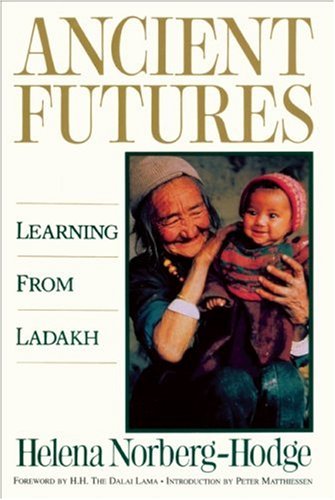Blurb:
The swiftly evolving socioeconomic life of Ladakh, whose people struggle to balance growth and technology with cultural values, offers crucial lessons in sustainable development. This gripping portrait of the western Himalayan land known as “Little Tibet” moves from the author’s first visit to idyllic, nonindustrial Ladakh in 1974 to the present, tracking profound changes as the region was opened to foreign tourists, Western goods and technologies, and pressures for economic growth. These changes in turn brought generational conflict, unemployment, inflation, environmental damage, and threats to the traditional way of life.
Appalled by these negative impacts, the author helped establish the Ladakh Project (later renamed the International Society for Ecology and Culture) to seek sustainable solutions that preserve cultural integrity and environmental health, while addressing the Ladakhis’ hunger for modernization. This model undertaking effectively combines educational programs for all social levels with the design, demonstration, and promotion of appropriate technologies such as solar heating and small-scale hydro power.
Examining how modernization changes the way people live and think, Norberg-Hodge challenges us to redefine our concepts of “development” and “progress.” Above all, Ancient Futures stresses the need to carry traditional wisdom into the future—our urgent task as a global community.
My Review:
“Ancient Futures: Learning from Ladakh” by Helena Norberg-Hodge explores the theme of sustainable development. The book emphasizes the importance of balancing modernization with preserving cultural values and environmental health. It critiques the notion of progress driven solely by economic growth, highlighting the negative consequences such as environmental damage, loss of cultural identity, and social conflicts.
One central theme is the clash between traditional self-reliance and modern dependency. The author illustrates how Ladakh’s once self-sufficient society is increasingly dependent on corporations and government institutions that prioritize short-term profits over long-term well-being. This dependency leads to problems like debt, environmental pollution, and social instability.
Another important theme is the value of traditional wisdom. The author argues that modern development should not discard the knowledge and practices that have sustained communities for centuries. Instead, there should be a blend of the old and the new, where modern technologies are adapted to fit within traditional frameworks.
The writing style of “Ancient Futures” is engaging and accessible, making complex issues understandable to a wide audience. The author uses vivid descriptions to bring Ladakh to life, painting a picture of its stunning landscapes and warm, welcoming people. Her storytelling approach makes the book enjoyable to read, as she shares personal experiences and anecdotes from her time in Ladakh.
The book also includes thoughtful reflections and critical analysis, prompting readers to question their own assumptions about development and progress. The author’s writing is both informative and inspiring, encouraging readers to consider more sustainable and culturally sensitive approaches to modernization.
“Ancient Futures: Learning from Ladakh” is a perfect read if you want to know more about Ladakh and its culture and people.

